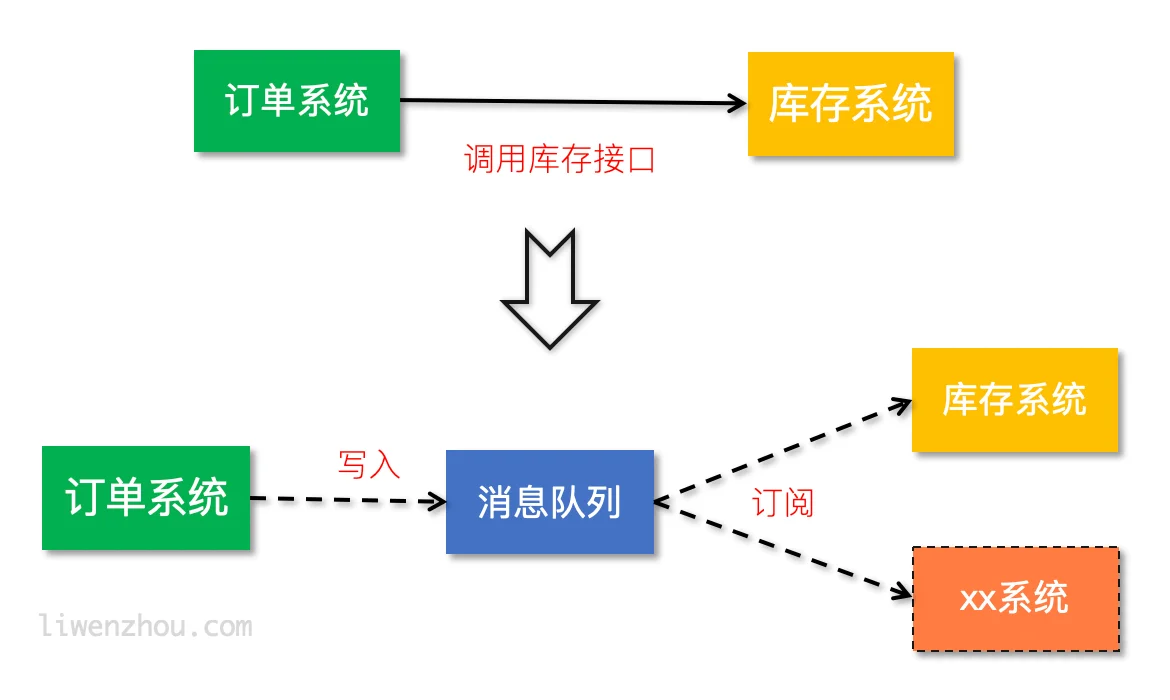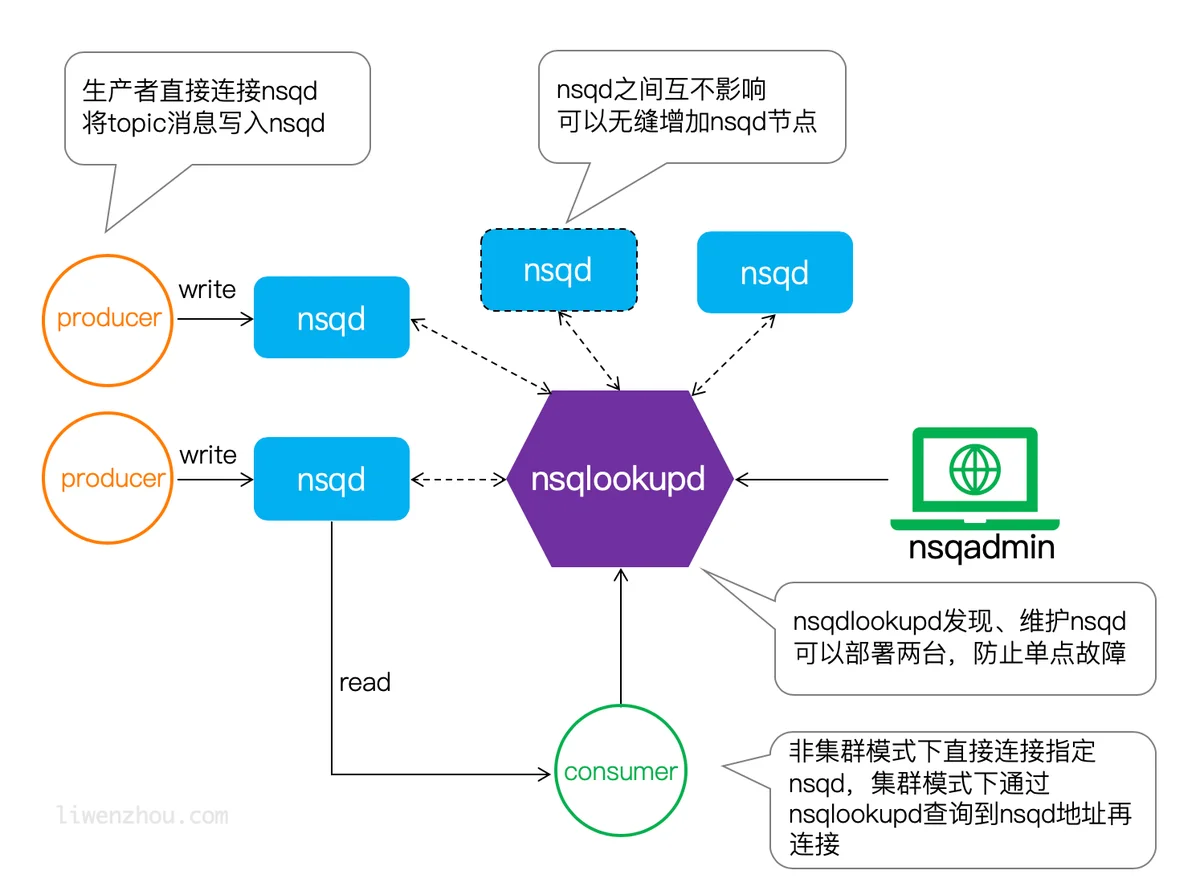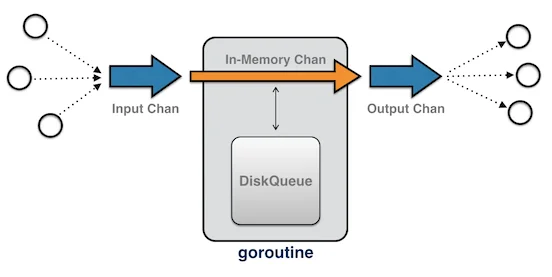NSQ是目前比较流行的一个分布式的消息队列,本文主要介绍了NSQ及Go语言如何操作NSQ。
NSQNSQ介绍
NSQ是Go语言编写的一个开源的实时分布式内存消息队列,其性能十分优异。 NSQ的优势有以下优势:
- NSQ提倡分布式和分散的拓扑,没有单点故障,支持容错和高可用性,并提供可靠的消息交付保证
- NSQ支持横向扩展,没有任何集中式代理。
- NSQ易于配置和部署,并且内置了管理界面。
NSQ的应用场景
通常来说,消息队列都适用以下场景。
异步处理
参照下图利用消息队列把业务流程中的非关键流程异步化,从而显著降低业务请求的响应时间。
应用解耦
通过使用消息队列将不同的业务逻辑解耦,降低系统间的耦合,提高系统的健壮性。后续有其他业务要使用订单数据可直接订阅消息队列,提高系统的灵活性。
流量削峰
类似秒杀(大秒)等场景下,某一时间可能会产生大量的请求,使用消息队列能够为后端处理请求提供一定的缓冲区,保证后端服务的稳定性。[外链图片转存失败,源站可能有防盗链机制,建议将图片保存下来直接上传(img-uS2BrIJW-1656424269336)(https://www.liwenzhou.com/images/Go/nsq/nsq3.png)]
安装
官方下载页面根据自己的平台下载并解压即可。
NSQ组件
nsqd
nsqd是一个守护进程,它接收、排队并向客户端发送消息。
nsqd-broadcast-address=127.0.0.1./nsqd -broadcast-address=127.0.0.1
nsqlookupdnsqlookupd./nsqd -broadcast-address=127.0.0.1 -lookupd-tcp-address=127.0.0.1:4160
nsqlookupd-lookupd-tcp-addressnsqdq-auth-http-address value
<addr>:<port> to query auth server (may be given multiple times)
-broadcast-address string
address that will be registered with lookupd (defaults to the OS hostname) (default "PROSNAKES.local")
-config string
path to config file
-data-path string
path to store disk-backed messages
-deflate
enable deflate feature negotiation (client compression) (default true)
-e2e-processing-latency-percentile value
message processing time percentiles (as float (0, 1.0]) to track (can be specified multiple times or comma separated '1.0,0.99,0.95', default none)
-e2e-processing-latency-window-time duration
calculate end to end latency quantiles for this duration of time (ie: 60s would only show quantile calculations from the past 60 seconds) (default 10m0s)
-http-address string
<addr>:<port> to listen on for HTTP clients (default "0.0.0.0:4151")
-http-client-connect-timeout duration
timeout for HTTP connect (default 2s)
-http-client-request-timeout duration
timeout for HTTP request (default 5s)
-https-address string
<addr>:<port> to listen on for HTTPS clients (default "0.0.0.0:4152")
-log-prefix string
log message prefix (default "[nsqd] ")
-lookupd-tcp-address value
lookupd TCP address (may be given multiple times)
-max-body-size int
maximum size of a single command body (default 5242880)
-max-bytes-per-file int
number of bytes per diskqueue file before rolling (default 104857600)
-max-deflate-level int
max deflate compression level a client can negotiate (> values == > nsqd CPU usage) (default 6)
-max-heartbeat-interval duration
maximum client configurable duration of time between client heartbeats (default 1m0s)
-max-msg-size int
maximum size of a single message in bytes (default 1048576)
-max-msg-timeout duration
maximum duration before a message will timeout (default 15m0s)
-max-output-buffer-size int
maximum client configurable size (in bytes) for a client output buffer (default 65536)
-max-output-buffer-timeout duration
maximum client configurable duration of time between flushing to a client (default 1s)
-max-rdy-count int
maximum RDY count for a client (default 2500)
-max-req-timeout duration
maximum requeuing timeout for a message (default 1h0m0s)
-mem-queue-size int
number of messages to keep in memory (per topic/channel) (default 10000)
-msg-timeout string
duration to wait before auto-requeing a message (default "1m0s")
-node-id int
unique part for message IDs, (int) in range [0,1024) (default is hash of hostname) (default 616)
-snappy
enable snappy feature negotiation (client compression) (default true)
-statsd-address string
UDP <addr>:<port> of a statsd daemon for pushing stats
-statsd-interval string
duration between pushing to statsd (default "1m0s")
-statsd-mem-stats
toggle sending memory and GC stats to statsd (default true)
-statsd-prefix string
prefix used for keys sent to statsd (%s for host replacement) (default "nsq.%s")
-sync-every int
number of messages per diskqueue fsync (default 2500)
-sync-timeout duration
duration of time per diskqueue fsync (default 2s)
-tcp-address string
<addr>:<port> to listen on for TCP clients (default "0.0.0.0:4150")
-tls-cert string
path to certificate file
-tls-client-auth-policy string
client certificate auth policy ('require' or 'require-verify')
-tls-key string
path to key file
-tls-min-version value
minimum SSL/TLS version acceptable ('ssl3.0', 'tls1.0', 'tls1.1', or 'tls1.2') (default 769)
-tls-required
require TLS for client connections (true, false, tcp-https)
-tls-root-ca-file string
path to certificate authority file
-verbose
enable verbose logging
-version
print version string
-worker-id
do NOT use this, use --node-id
nsqlookupd
topicnsqlookupdnsqlookupd-broadcast-address string
address of this lookupd node, (default to the OS hostname) (default "PROSNAKES.local")
-config string
path to config file
-http-address string
<addr>:<port> to listen on for HTTP clients (default "0.0.0.0:4161")
-inactive-producer-timeout duration
duration of time a producer will remain in the active list since its last ping (default 5m0s)
-log-prefix string
log message prefix (default "[nsqlookupd] ")
-tcp-address string
<addr>:<port> to listen on for TCP clients (default "0.0.0.0:4160")
-tombstone-lifetime duration
duration of time a producer will remain tombstoned if registration remains (default 45s)
-verbose
enable verbose logging
-version
print version string
nsqadmin
nsqadminnsqlookupd./nsqadmin -lookupd-http-address=127.0.0.1:4161
http://127.0.0.1:4171/nsqadmin-allow-config-from-cidr string
A CIDR from which to allow HTTP requests to the /config endpoint (default "127.0.0.1/8")
-config string
path to config file
-graphite-url string
graphite HTTP address
-http-address string
<addr>:<port> to listen on for HTTP clients (default "0.0.0.0:4171")
-http-client-connect-timeout duration
timeout for HTTP connect (default 2s)
-http-client-request-timeout duration
timeout for HTTP request (default 5s)
-http-client-tls-cert string
path to certificate file for the HTTP client
-http-client-tls-insecure-skip-verify
configure the HTTP client to skip verification of TLS certificates
-http-client-tls-key string
path to key file for the HTTP client
-http-client-tls-root-ca-file string
path to CA file for the HTTP client
-log-prefix string
log message prefix (default "[nsqadmin] ")
-lookupd-http-address value
lookupd HTTP address (may be given multiple times)
-notification-http-endpoint string
HTTP endpoint (fully qualified) to which POST notifications of admin actions will be sent
-nsqd-http-address value
nsqd HTTP address (may be given multiple times)
-proxy-graphite
proxy HTTP requests to graphite
-statsd-counter-format string
The counter stats key formatting applied by the implementation of statsd. If no formatting is desired, set this to an empty string. (default "stats.counters.%s.count")
-statsd-gauge-format string
The gauge stats key formatting applied by the implementation of statsd. If no formatting is desired, set this to an empty string. (default "stats.gauges.%s")
-statsd-interval duration
time interval nsqd is configured to push to statsd (must match nsqd) (default 1m0s)
-statsd-prefix string
prefix used for keys sent to statsd (%s for host replacement, must match nsqd) (default "nsq.%s")
-version
print version string
NSQ架构
NSQ工作模式

Topic和Channel
“topics”topic“channels”channeltopicchanneltopictopicchanneltopictopictopicchannelchannelchanneltopicchannelchenneltopicchanneltopic -> channelchannel -> consumersNSQ接收和发送消息流程

NSQ特性
--mem-queue-sizeGo操作NSQ
官方提供了Go语言版的客户端:go-nsq,更多客户端支持请查看CLIENT LIBRARIES。
安装
go get -u github.com/nsqio/go-nsq
生产者
一个简单的生产者示例代码如下:
// nsq_producer/main.go
package main
import (
"bufio"
"fmt"
"os"
"strings"
"github.com/nsqio/go-nsq"
)
// NSQ Producer Demo
var producer *nsq.Producer
// 初始化生产者
func initProducer(str string) (err error) {
config := nsq.NewConfig()
producer, err = nsq.NewProducer(str, config)
if err != nil {
fmt.Printf("create producer failed, err:%v\n", err)
return err
}
return nil
}
func main() {
nsqAddress := "127.0.0.1:4150"
err := initProducer(nsqAddress)
if err != nil {
fmt.Printf("init producer failed, err:%v\n", err)
return
}
reader := bufio.NewReader(os.Stdin) // 从标准输入读取
for {
data, err := reader.ReadString('\n')
if err != nil {
fmt.Printf("read string from stdin failed, err:%v\n", err)
continue
}
data = strings.TrimSpace(data)
if strings.ToUpper(data) == "Q" { // 输入Q退出
break
}
// 向 'topic_demo' publish 数据
err = producer.Publish("topic_demo", []byte(data))
if err != nil {
fmt.Printf("publish msg to nsq failed, err:%v\n", err)
continue
}
}
}
123456$ ./nsq_producer
123
2018/10/22 18:41:20 INF 1 (127.0.0.1:4150) connecting to nsqd
456
http://127.0.0.1:4171/topictopic_demotopicLWZMBP:4151 (127.0.01:4151)nsqdchannel/nodeslookupdnsqd/counter/lookuptopicchannel消费者
一个简单的消费者示例代码如下:
// nsq_consumer/main.go
package main
import (
"fmt"
"os"
"os/signal"
"syscall"
"time"
"github.com/nsqio/go-nsq"
)
// NSQ Consumer Demo
// MyHandler 是一个消费者类型
type MyHandler struct {
Title string
}
// HandleMessage 是需要实现的处理消息的方法
func (m *MyHandler) HandleMessage(msg *nsq.Message) (err error) {
fmt.Printf("%s recv from %v, msg:%v\n", m.Title, msg.NSQDAddress, string(msg.Body))
return
}
// 初始化消费者
func initConsumer(topic string, channel string, address string) (err error) {
config := nsq.NewConfig()
config.LookupdPollInterval = 15 * time.Second
c, err := nsq.NewConsumer(topic, channel, config)
if err != nil {
fmt.Printf("create consumer failed, err:%v\n", err)
return
}
consumer := &MyHandler{
Title: "沙河1号",
}
c.AddHandler(consumer)
// if err := c.ConnectToNSQD(address); err != nil { // 直接连NSQD
if err := c.ConnectToNSQLookupd(address); err != nil { // 通过lookupd查询
return err
}
return nil
}
func main() {
err := initConsumer("topic_demo", "first", "127.0.0.1:4161")
if err != nil {
fmt.Printf("init consumer failed, err:%v\n", err)
return
}
c := make(chan os.Signal) // 定义一个信号的通道
signal.Notify(c, syscall.SIGINT) // 转发键盘中断信号到c
<-c // 阻塞
}
将上面的代码保存之后编译执行,就能够获取之前我们publish的两条消息了:
$ ./nsq_consumer
2018/10/22 18:49:06 INF 1 [topic_demo/first] querying nsqlookupd http://127.0.0.1:4161/lookup?topic=topic_demo
2018/10/22 18:49:06 INF 1 [topic_demo/first] (127.0.0.1:4150) connecting to nsqd
沙河1号 recv from 127.0.0.1:4150, msg:123
沙河1号 recv from 127.0.0.1:4150, msg:456
/countergo-nsq参考链接:https://www.liwenzhou.com/posts/Go/go_nsq/
